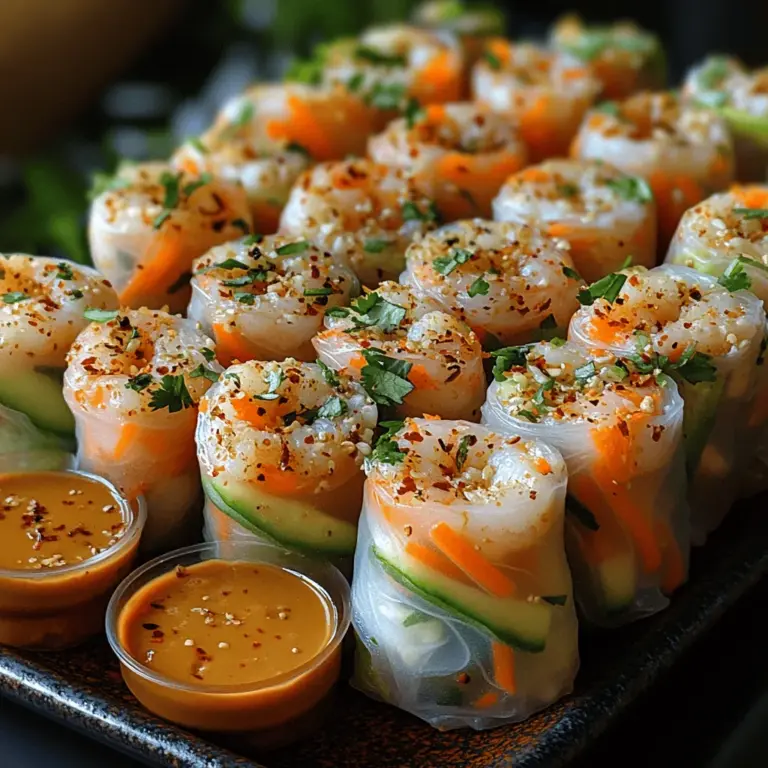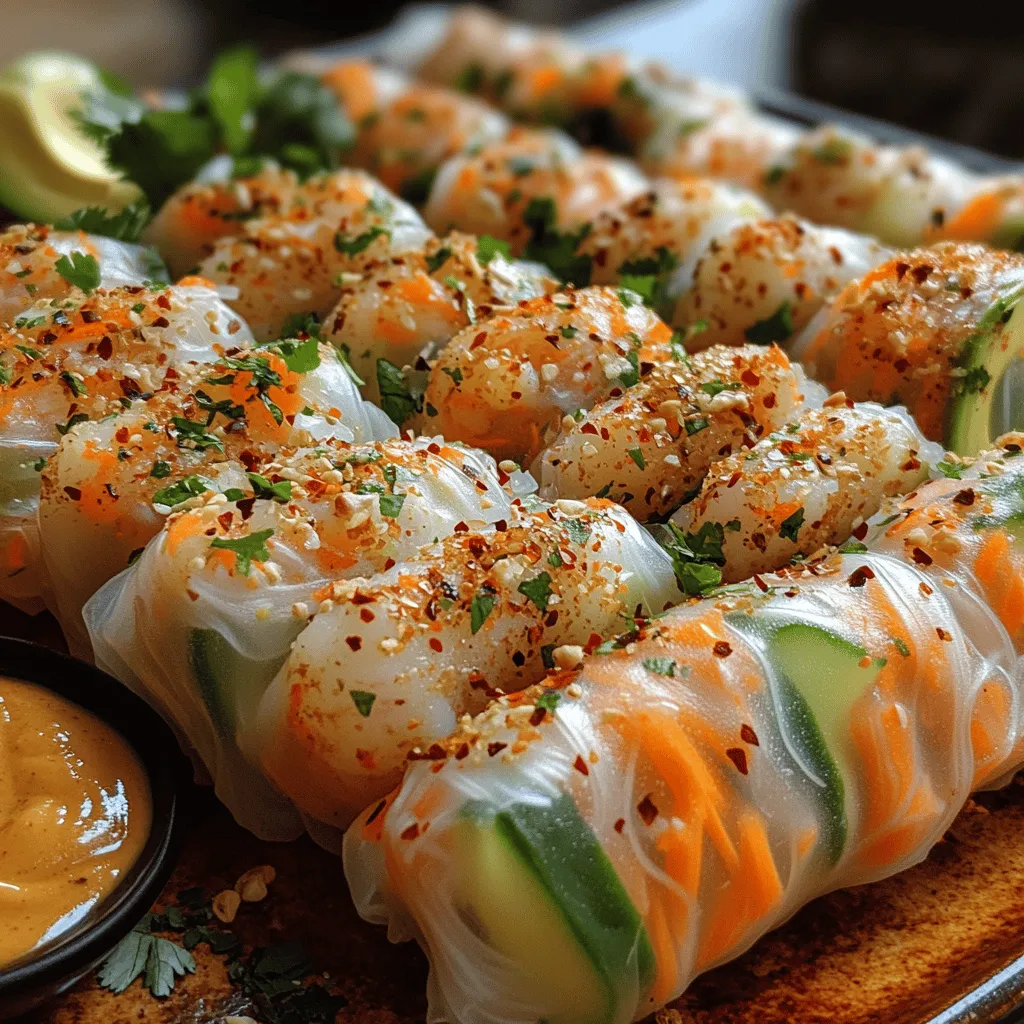Spring rolls are not only a staple in many Asian cuisines but also a delightful and healthy culinary treasure enjoyed by food lovers around the globe. These vibrant rolls bring together a medley of fresh vegetables, fragrant herbs, and the satisfying crunch of rice paper, making them a perfect option for any occasion. Our recipe for Crunchy Delight Spring Rolls encapsulates the essence of this beloved dish while offering a customizable experience to cater to various dietary preferences.
Whether you’re looking for a refreshing appetizer to kick off a dinner party or a light meal that won’t weigh you down, these spring rolls are sure to impress your family and friends. Their versatility means you can mix and match ingredients based on what’s in season or what you have on hand. The delightful crunch, combined with the explosion of flavors from fresh herbs and vegetables, makes each bite an enjoyable experience.
In this article, we will explore the essential ingredients that make up our Crunchy Delight Spring Rolls, the cultural significance of these rolls, and provide detailed preparation methods. By the end of this guide, you will have a comprehensive understanding of this beloved dish and the confidence to recreate it in your own kitchen.
Understanding the Ingredients: A Closer Look at What Goes Into Crunchy Delight Spring Rolls
To create the perfect Crunchy Delight Spring Rolls, it is essential to understand the ingredients that contribute to their unique flavor and texture. Let’s break down these core components:
Rice Paper: The Foundation of the Spring Roll
Rice paper is the key ingredient that forms the outer layer of the spring rolls. Made from rice flour and water, it is gluten-free and provides a delicate yet sturdy wrapper that encases the filling. The texture of rice paper is unique; it becomes soft and pliable when soaked in warm water, allowing for easy rolling. The neutral flavor of rice paper also allows the vibrant fillings to shine, making it a perfect choice for spring rolls.
Vermicelli Noodles: Adding Texture and Heartiness
Vermicelli noodles, thin rice noodles often found in Southeast Asian dishes, add an element of texture and heartiness to the spring rolls. They are light yet filling, providing a satisfying bite without overwhelming the other ingredients. Cooking vermicelli noodles is quick and easy, and they serve as a great base for the fresh vegetables and herbs that will be included.
Fresh Vegetables: Shredded Carrots, Cucumbers, and Bell Peppers for Crunch
Fresh vegetables are essential for providing crunch and color in your spring rolls. Shredded carrots add a touch of sweetness and vibrant orange color, while cucumbers bring refreshing crispness. Bell peppers add a splash of color and a sweet, juicy bite. These vegetables not only enhance the visual appeal but also contribute essential vitamins and minerals, making your spring rolls a nutritious option.
Herbs: The Role of Cilantro and Mint in Flavor Enhancement
No spring roll is complete without fresh herbs, which elevate the flavor profile of the dish. Cilantro and mint are the traditional choices that add a burst of freshness and complexity. Cilantro offers a slightly peppery flavor, while mint provides a cooling effect that balances the other ingredients. Using fresh herbs can transform your spring rolls from ordinary to extraordinary, making each bite aromatic and flavorful.
Protein Options: Shrimp or Tofu for a Nutritious Boost
To make your Crunchy Delight Spring Rolls more filling, consider adding a source of protein. Shrimp is a popular choice that pairs well with the other ingredients, adding a subtle sweetness and a delightful texture. For a vegetarian or vegan option, tofu is an excellent alternative that absorbs flavors beautifully while providing a healthy source of protein. Both options enhance the nutritional value of the dish, making it a well-rounded meal.
Flavor Enhancers: Soy Sauce and Sesame Oil
To finish off your spring rolls, don’t forget to incorporate flavor enhancers that will bring all the ingredients together. A light drizzle of soy sauce can add a savory depth, while sesame oil contributes a warm, nutty flavor. These ingredients not only enhance the taste but also add an aromatic quality that makes the spring rolls irresistible.
Nutritional Benefits of the Ingredients
The beauty of Crunchy Delight Spring Rolls lies not only in their taste but also in their nutritional profile. Here’s a closer look at the benefits of the key ingredients:
– Vitamins and Minerals in Vegetables: The fresh vegetables used in spring rolls are rich in vitamins A and C, as well as essential minerals like potassium and magnesium. These nutrients contribute to overall health and well-being.
– Health Advantages of Herbs: Fresh herbs like cilantro and mint are packed with antioxidants and have been linked to various health benefits, including improved digestion and anti-inflammatory properties.
– Balancing Protein Sources with Shrimp or Tofu: Adding shrimp or tofu provides a healthy source of protein, essential for muscle repair and overall body function. This balance of macronutrients makes spring rolls a satisfying meal option.
– Caloric Considerations of the Dish: Spring rolls are relatively low in calories, especially when compared to fried alternatives, making them a guilt-free choice. The combination of fresh ingredients means you can enjoy a generous serving without compromising your dietary goals.
Preparation Steps: Crafting Your Crunchy Delight Spring Rolls
Now that we understand the ingredients that come together to create these delightful spring rolls, it’s time to dive into the preparation process. Here’s a detailed breakdown of how to craft your Crunchy Delight Spring Rolls, starting with the cooking of vermicelli noodles.
Cooking Vermicelli Noodles: Instructions for Perfect Noodles
1. Boil Water: Start by bringing a pot of water to a rolling boil. You’ll need enough water to fully submerge the vermicelli noodles.
2. Add the Noodles: Once the water is boiling, add the vermicelli noodles to the pot. Use the package instructions as a guide, typically cooking for about 3-5 minutes. Stir gently to prevent the noodles from sticking together.
3. Check for Doneness: After the recommended cooking time, taste a noodle to ensure it’s cooked to your liking. The noodles should be tender but still have a slight bite.
4. Drain and Rinse: Once cooked, promptly drain the noodles in a colander and rinse them under cold running water to stop the cooking process. This also helps to keep the noodles from becoming sticky.
5. Set Aside: Allow the noodles to drain completely, then transfer them to a bowl. You can toss them with a small amount of sesame oil to prevent sticking and add flavor.
As you prepare the other ingredients, your vermicelli noodles will be ready to be incorporated into the spring rolls, bringing the dish together beautifully. In the next sections, we will explore the assembly of the spring rolls, along with tips and tricks to ensure they turn out perfectly every time.
Preparing Vegetables: Techniques for Shredding and Slicing
When it comes to crafting the perfect Crunchy Delight Spring Rolls, the preparation of vegetables is crucial. Fresh, vibrant vegetables not only enhance the flavor but also contribute to the visual appeal of your spring rolls. Here are some techniques to ensure your vegetables are perfectly shredded and sliced:
1. Choosing the Right Vegetables: Freshness is key. Opt for a variety of vegetables such as carrots, cucumbers, bell peppers, and red cabbage for a colorful mix. Each vegetable brings unique textures and flavors, enhancing the overall experience.
2. Shredding: For vegetables like carrots and cabbage, using a box grater or a food processor with a shredding attachment can save you time and ensure uniformity. If you prefer a more artisanal approach, a sharp knife can be used to julienne these vegetables. Aim for thin, even slices to ensure they fit well within the rice paper.
3. Slicing: For vegetables that are meant to be sliced rather than shredded, such as cucumbers and bell peppers, use a sharp knife to create thin, matchstick-sized pieces. This not only makes them easier to roll but also allows for a delightful crunch with each bite.
4. Soaking in Water: After shredding and slicing, you can soak tougher vegetables like carrots and cabbage in cold water for about 10-15 minutes. This will help to crisp them up and enhance their crunchiness, making your spring rolls even more delightful.
Soaking Rice Paper: Tips for Achieving the Ideal Texture
The rice paper wrapper is fundamental to the spring roll experience. Getting it just right is essential for a successful roll. Here are some tips for soaking rice paper to achieve the ideal texture:
1. Choosing the Right Rice Paper: Select high-quality rice paper that is ideally suited for spring rolls. Look for brands that are gluten-free and made from natural ingredients.
2. Soaking Method: Fill a shallow dish or plate with warm water. One at a time, dip each rice paper sheet into the water for about 10-15 seconds or until it becomes pliable. Avoid soaking for too long, as this can make the rice paper too soft and prone to tearing.
3. Resting the Wrapper: After soaking, gently lay the rice paper on a clean, dry surface for a few moments. This allows excess moisture to evaporate, which helps in achieving the right level of tackiness for rolling.
4. Handling with Care: When handling the soaked rice paper, be gentle. It is delicate and can tear easily if mishandled. Work quickly, as dried rice paper can become difficult to manipulate.
Layering Ingredients: Best Practices for Balanced Filling
The key to a delightful Crunchy Delight Spring Roll lies not just in the ingredients but also in how you layer them. Here are some best practices for achieving a balanced filling:
1. Base Layer: Start with a base layer of leafy greens such as lettuce or spinach. This creates a barrier that helps keep the moisture from the other fillings from making the rice paper soggy.
2. Adding Vegetables: Next, layer your shredded and sliced vegetables. Aim for a mix of colors and textures, varying from crunchy to tender. This not only makes for a more appealing roll but also creates a harmony of flavors.
3. Protein Options: If desired, add a protein source such as grilled shrimp, tofu, or chicken. Make sure to cut any proteins into thin strips to ensure they roll easily and distribute evenly throughout the spring roll.
4. Herbs and Seasoning: Fresh herbs like mint, cilantro, or basil can elevate the flavor profile of your spring rolls. Sprinkle them in at the end of your layering process for a fresh burst of flavor.
5. Not Overstuffing: Be cautious not to overstuff your spring rolls. A well-balanced filling should allow for easy rolling without tearing the rice paper. Approximately 2-3 tablespoons of filling per roll is a good rule of thumb.
Rolling Technique: Ensuring a Snug, Yet Tear-Free Roll
Rolling spring rolls can be a bit tricky, but with the right technique, you can master it. Follow these steps to ensure a snug, yet tear-free roll:
1. Positioning the Fillings: Place your layered ingredients about 1/3 of the way from the bottom of the rice paper. This gives you enough room to fold over and secure the filling.
2. Folding the Bottom: Begin by folding the bottom edge of the rice paper over the filling. Press down gently to secure the filling in place.
3. Folding the Sides: Next, fold the left and right sides of the rice paper towards the center. This will help to encase the filling securely.
4. Rolling Up: With the sides tucked in, continue rolling the spring roll upwards until you reach the top edge of the rice paper. Use your fingers to tuck and roll tightly but gently, ensuring the filling is snug without tearing the wrapper.
5. Sealing the Roll: To seal the roll, you can lightly moisten the top edge of the rice paper with a bit of water. This will help it stick together and keep your roll intact.
Serving Suggestions: Presenting Your Spring Rolls with Style
Once your Crunchy Delight Spring Rolls are beautifully rolled, it’s time to present them. Here are some creative serving suggestions that will impress your guests:
1. Creative Plating Ideas: Arrange your spring rolls on a large serving platter. Consider a circular or fan-like arrangement for visual appeal. You can also serve them in individual bamboo baskets or on a bed of lettuce for a rustic touch.
2. Choosing the Right Dipping Sauces: The choice of dipping sauce can elevate your spring roll experience. Sweet chili sauce offers a delightful contrast to the crunchy freshness of the rolls. Peanut sauce, rich and creamy, adds depth and a nutty flavor that pairs beautifully with the vegetables.
3. Garnishing for an Elegant Touch: To enhance the presentation, garnish your platter with fresh herbs, edible flowers, or thinly sliced colorful vegetables. A sprinkle of sesame seeds can also add a nice touch, creating a visually appealing and appetizing display.
Cultural Significance: The Role of Spring Rolls in Global Cuisine
Spring rolls are not just a delicious dish; they carry rich cultural significance across the globe. Understanding their history and variations can deepen your appreciation for this culinary treasure.
1. Origins of Spring Rolls in Asian Cuisine: Spring rolls are believed to have originated in China, dating back to the 4th century. Initially, they were a seasonal dish enjoyed during the Spring Festival, symbolizing wealth and prosperity. The traditional fillings have evolved, reflecting regional ingredients and culinary practices.
2. Variations Across Cultures: Different cultures have embraced spring rolls, leading to a wide variety of interpretations. In Vietnam, for instance, they are known as “gỏi cuốn” and are often served fresh with a dipping sauce. In contrast, Chinese spring rolls are typically deep-fried and served as an appetizer. Other countries, such as Thailand and Indonesia, have their own unique takes, showcasing the versatility of this dish.
3. Celebrating Diversity in Spring Roll Recipes: The beauty of spring rolls lies in their adaptability. You can experiment with various fillings and sauces to suit your dietary preferences. From vegan options using tofu and a medley of vegetables to gluten-free wrappers made from rice, the possibilities are endless.
4. Adapting Spring Rolls for Vegan and Gluten-Free Diets: With growing awareness of dietary restrictions, many have adapted spring rolls to cater to vegan and gluten-free diets. Using rice paper wraps and filling them with a variety of plant-based ingredients allows everyone to enjoy this delightful dish.
Conclusion: Embrace the Crunchy Delight of Spring Rolls in Your Kitchen
Crunchy Delight Spring Rolls are more than just a dish; they are a celebration of fresh ingredients, vibrant flavors, and culinary creativity. By preparing these delightful rolls, you not only enjoy a delicious meal but also connect with a rich cultural tradition. The versatility of spring rolls allows you to customize them to your taste, making them suitable for any occasion.
With this comprehensive guide, you’re equipped to make your own Crunchy Delight Spring Rolls and share the joy of this delightful dish with others. Whether you serve them as an appetizer at your next gathering or as a light meal during the week, these spring rolls are sure to impress. Embrace the flavors, techniques, and cultural significance of this beloved dish, and enjoy the crunchy delight it brings to your kitchen!



